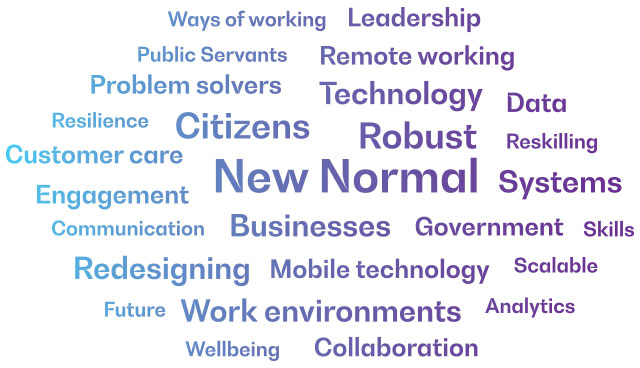The ‘new normal’ for public servants

A large reset button has been pressed on the world’s economy and its societies. Citizens and businesses have all been operating in restricted mode. But when the reboot is completed, we will all have to learn and adjust to a new economic and societal ‘operating system’ and ‘user interface’ writes Andrew Montgomery, Partner and Global Leader Government and Public Sector at BearingPoint.
What are the key considerations and challenges in designing this ‘new normal’ for Europe’s public servants? Their ways of working, work environments, the employee experience, and the skills and technologies they need to be effective in their roles.
All industries have had to manage and operate through a rapidly changing economic environment that evolved over days and weeks: first from ‘business as usual’ to ‘business as not usual’ as social and mobility restrictions had an immediate impact on revenues and service delivery. As the new levels of supply and demand for services have become clearer, organisations are operating in a new manner: ‘business as unusual’.
Through the period following the relaxation of restrictions, organisations will need to implement the permanent changes to their business and operating models to be successful and effective in whatever ‘new normal’ economic and social environment materialises.
The public service has had to respond incredibly quickly and innovatively to the increased demand from citizens for its services:
• on the frontline in hospitals and nursing homes, through contact tracing and testing of citizens, the sourcing and supply of personal protective equipment and the implementation of population health management and communications plans;
• in other frontline areas like social care, policing, emergency responders, local government and education where public servants are dealing with extra demands placed on them, and working in an environment of uncertainly and, in some areas, higher risk; and
• also, the redeployment of public servants from non-frontline roles to support the areas of the public service experiencing increased demand has resulted in a high proportion of people working in areas outside of their core domain and competencies, using unfamiliar work and management practices.
Public servants are playing a key and irreplaceable role in tackling and managing the many challenges that the Covid-19 crisis has presented and are demonstrating their flexibility and resourcefulness. The situation will stabilise, but it is clear we will all be working and living in a different reality. This presents uncertainties, but also opportunities, in the medium to longer term. For public service organisations, and specifically public servants themselves, there are six key areas for consideration that are clearly emerging.
1. The future of work is today
In Ireland, the draft programme for government that has been presented includes an ambition that 20 per cent of public servants should be working remotely by 2021 (and private-sector employers will be incentivised to do likewise). Whatever the actual figure is, and it could arguably be higher, the potential positive outcomes for society, the economy and the environment are clear. It would reduce congestion on roads and public transportation, reduce emissions, increase daily productivity time, and improve citizen wellbeing.
The ‘new normal’ will not see a return to the same levels of office-based work, and the balance will vary across different sectors. To prepare for this, public service managers need to design and implement permanent changes in areas including:
• full implementation of robust, scalable and secure communications infrastructure to support remote working and collaboration, both internally and externally;
• the rationalisation of its real estate portfolio and reconfiguration of workspaces to facilitate social distancing at work; and
• redesigning HR and workforce management processes to support new work patterns, work-sharing models and ways of working, supported by the appropriate training.
2. It is a people business and always will be
Compared to other industry sectors, the public service has a high proportion of its workforce who deliver services face-to-face on the frontline to its customers – be they citizens or businesses – or in the middle or back-office in terms of second-level supporting services, i.e. case management and customer care. Other industry sectors have seen a significant reduction in the human element of either the manufacturing of products, through automation or the delivery of services via digitalisation of customer channels.

However, there is a difference between deploying technology to automate processes and using it to enable the people who deliver them. It is the latter scenario that is more appropriate for public services. Citizens expect the same options in terms of digital and physical channels from the public service as they get as consumers. They also expect frontline public servants, whether they are nurses, teachers or police officers, to be equipped with and have access to the appropriate technology and data to respond quickly and deliver their service needs.
Supporting frontline public servants to deliver services more effectively requires:
• equipping them with the appropriate mobile technology and access to systems and data to triage, resolve, refer or escalate situations in as close to real-time as possible;
• redesigning existing processes to balance remote monitoring, video or in-person interactions (i.e. medical assessments, adjudications etc.) and determine when each is appropriate and effective; and
• making multi-agency approaches the norm and designing integrated services around the specific needs of citizen groups (i.e. elderly people and those living in remote areas) to provide an improved experience and outcome.
3. Its services are more complex and multi-faceted than other sectors
The discussion in relation to the demands of various public service roles in comparison to ones at equivalent levels of seniority and experience in the private sector will be an important agenda item. The roles of nurses, social care professionals, police officers, local government workers and teachers, for example, have had a much greater profile and focus during the current crisis. There are a number of areas for consideration including: the physical working environment they are in day-to-day; the non-discretionary aspect of the customers they serve; the situational factors they need to consider in providing the appropriate level of service; the implications on people’s lives of making an incorrect decision; and the levels of personal risk.
The multi-faceted and diverse nature of many public service careers is a fundamental element of the overall employee value proposition. Attracting and retaining public servants to manage and deliver the level of services we expect will require a reassessment of elements of this employee value proposition, including:
• the career and progression paths that it can provide and balance between providing both generalist and specialist roles at different levels and grades;
• the levers that are available to public service managers to support reward and performance management; and
• a best-in-class wellbeing programme that supports public servants who work in demanding frontline environments.
4. It needs ‘problem solvers’ over ‘process followers’
Regardless of the current situation, rapidly changing working conditions and circumstances are now part of employees’ and managers’ everyday lives in both the public and private sector. Essentially, the culture and mindset of organisations have to change when faced with a world of increased volatility, uncertainty, complexity and ambiguity. A new set and base-level of competencies are required for employees to be effective in their roles. These include aspects such as flexibility, agility, resilience, readiness to assume risk, problem-solving, dynamic communication and decision making, and a higher tolerance for failure.

Many public servants have demonstrated their aptitude in problem-solving during the current crisis and it is a fundamental aspect of the overall matrix of skills they require. From an overall workforce development perspective, the key activities should include:
• implementation of a revised competency and self-assessment framework to reflect the core capabilities that public servants require in their ‘new normal’ roles in today’s society and economy;
• providing access to appropriate learning and development programmes and delivery mechanisms aligned with the level and specialisms of public servants’ roles; and
• an increased focus on the organisation and presentation of information from multiple sources to support public servants in real-time, data-driven decision making.
5. Investment needs to be rebalanced towards its people
People, capability and leadership are generally cited as top success factors for public sector transformation. But often a disproportionate amount of the investment in transformation and change is made in digital solutions and technology.
There is a new balance to be struck between investing in transforming technology, processes, organisational structures and people development. And organisations need to consider the following in their decisions:
• revising existing business case models in terms of where the money will be spent, what outcomes it is intended to achieve and where the quantitative and qualitative value will be delivered;
• developing the new skills that public servant managers require as they advance within their organisations so they can allocate their time accordingly in terms of directing, motivating and supporting their teams; and
• implementing a consistent organisational change approach that is understood by the whole organisation and becomes business as usual in terms of both continuous improvement or more transformative initiatives.
6. It is about reskilling and redeployment of roles as opposed to them becoming redundant
In some sectors of the public service, as well as in regional areas away from population centres, there may not be enough frontline public servants. Technology has an important role to play in increasing the effectiveness of back-office and supporting processes and freeing up human and financial resources that can be dedicated to improving frontline services and higher-value activities or reassigned to other areas of increased demand.
The current crisis has seen significant redeployment of resources on a reactive basis and out of necessity. A longer-term and more strategic approach should be developed that includes:
• a sector-wide strategic workforce plan that includes the workforce profile (e.g. level, age, location and skills), drivers of service demand, workplace capacity and dynamic modelling capability for the reskilling, reactive and proactive redeployment of staff and impact of new technologies;
• development of new national models based on the learnings from current working arrangements that rebalance the centralised location of offices and staff to more remote and distributed arrangements; and
• the formalisation of arrangements for access to increased workforce capacity at short notice as part of business continuity management.
The ’new normal’ in terms of how, where and when we all work will be significantly different to the models we were used to before the crisis. This is presenting challenges and uncertainties in the short term. But it is also providing valuable lessons and insights into the future of work which has arrived much sooner than expected.
There can be many benefits to these new arrangements for citizens, businesses and wider society if introduced in a balanced way. As they have done in the current crisis, public servants can take the lead in establishing these new ways of working as the ‘new normal’.
This article is an extract from our BearingPoint of View on the priorities for public service organisations to enable new and effective ways of working for public servants in the ‘new normal’ society and economy. Visit www.bearingpoint.com/en-ie/our-success/insights/thenewnormal/ to read the full article.
Andrew Montgomery, Partner and Global Leader Government and Public Sector
T: +353 (1) 418 1176
E: andrew.montgomery@bearingpoint.com






